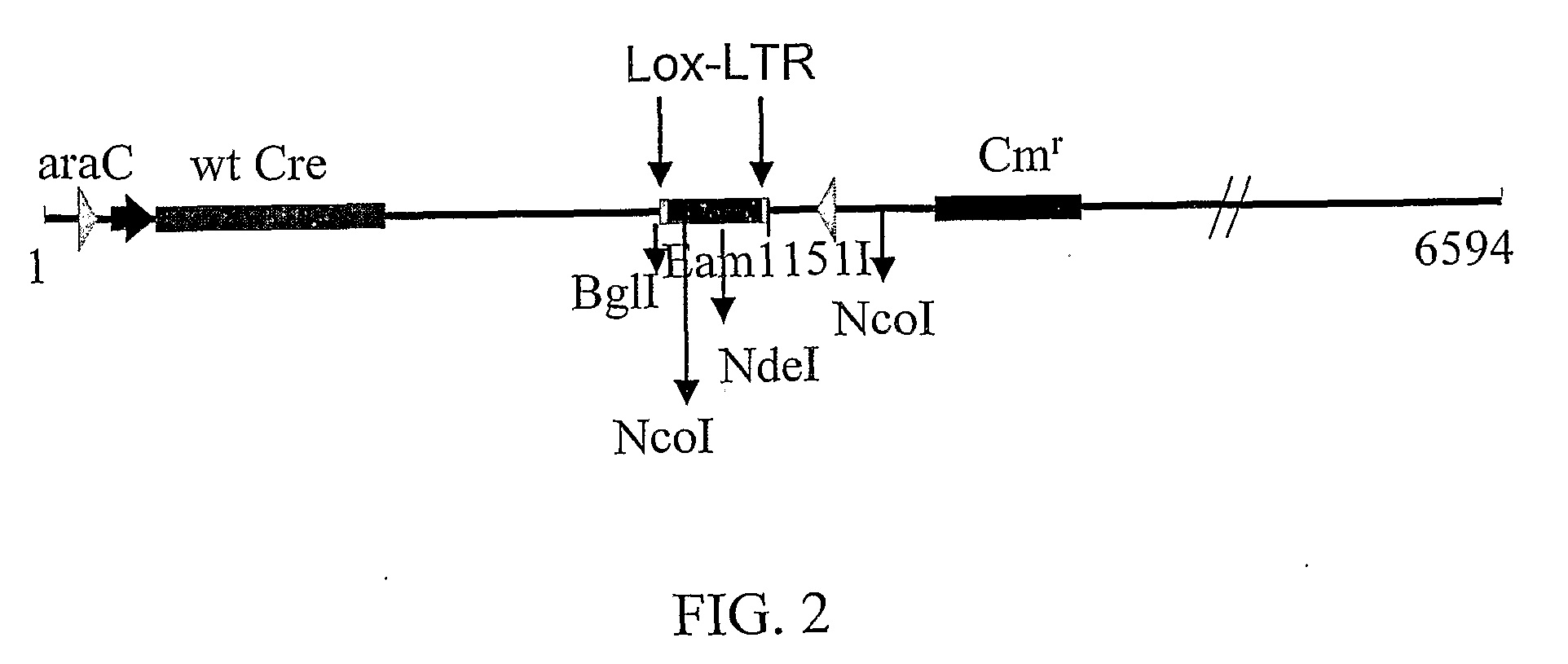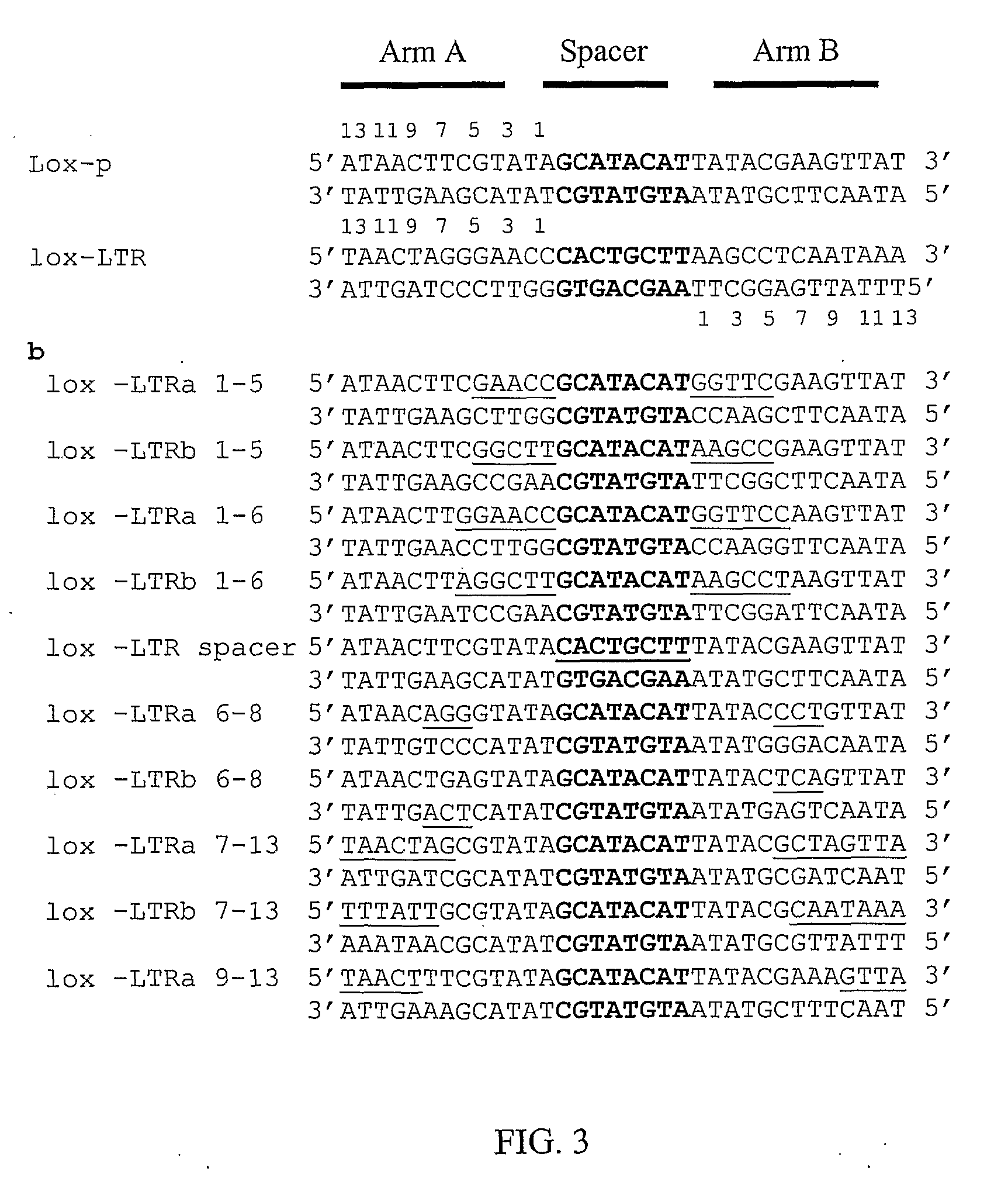A conserved region of the hiv-1 genome and uses thereof
a conserved region and genome technology, applied in the field of isolated polynucleotides, can solve the problem of not being a suitable target, and achieve the effect of high suitability as a targ
- Summary
- Abstract
- Description
- Claims
- Application Information
AI Technical Summary
Benefits of technology
Problems solved by technology
Method used
Image
Examples
example 1
Activity of Wild Type Cre Enzyme on lox-LTR Variant Sequences
[0138]Cre enzyme activity was tested using derivatives of the vector pBAD-33 (SEQ ID NO:30; Buchholz and Stewart (2001) Nat. Biotechnol. 19: 1047-1052, 2001). A schematic representation of derivatives of pBAD-33 is shown in FIG. 2. The vector contains two loxP-type sites and can be used for screening to identify Cre variants that recognize the sites. Between the two loxP sites is a 294 bp fragment that contains one of the two NcoI sites and the unique NdeI site of the vector. Cre-mediated recombination thus generates a circular product that is not digested by NdeI and is linearized by NcoI (or NdeI / NcoI digestion), yielding a 6440 bp fragment. PCR amplification of the lox-containing region of a recombined plasmind yields a 1950 bp PCR product. If the pBAD-33 vector has not undergone recombination, digestion with NcoI+NdeI gives rise to 5440 bp and 1300 bp fragments. PCR of the undigested, unrecombined plasmid yields a 2244...
example 2
Identification of Cre Variants Recognizing Novel Cre Sites
Materials and Experimental Methods
[0144]Library Production
[0145]Three different approaches were taken for mutating the gene encoding wild-type Cre recombinase:
[0146]1. Arbitrary substitutions of amino acids along the entire coding region of Cre, generated by error-prone PCR.
[0147]2. Site-directed mutagenesis along the coding region of Cre of 50 amino acids involved in the DNA interaction between Cre and lox-P, based on the crystal structure. The library was constructed to enable all possible amino acid substitutions within the 50 amino acids sites, with a 50% chance for a substitution at each single amino acid. This method is achieved using degenerate primers containing NNK codon. In each case, the N nucleotide mixture contained 70% restoration of the original nucleotide and 10% for each of the other 3 nucleotides. The K nucleotide mixture contained 50% each of guanine and thymine nucleotides.
[0148]3. Rational design of Cre b...
PUM
| Property | Measurement | Unit |
|---|---|---|
| Structure | aaaaa | aaaaa |
| Nucleic acid sequence | aaaaa | aaaaa |
Abstract
Description
Claims
Application Information
 Login to View More
Login to View More - R&D
- Intellectual Property
- Life Sciences
- Materials
- Tech Scout
- Unparalleled Data Quality
- Higher Quality Content
- 60% Fewer Hallucinations
Browse by: Latest US Patents, China's latest patents, Technical Efficacy Thesaurus, Application Domain, Technology Topic, Popular Technical Reports.
© 2025 PatSnap. All rights reserved.Legal|Privacy policy|Modern Slavery Act Transparency Statement|Sitemap|About US| Contact US: help@patsnap.com



